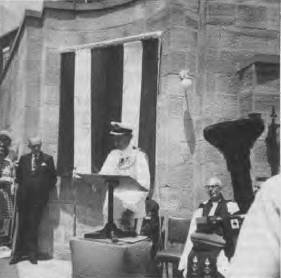- Author
- Lind, L.J.
- Subjects
- History - general
- Tags
-
- RAN Ships
- None noted.
- Publication
- December 1990 edition of the Naval Historical Review (all rights reserved)
In the meantime approval to erect the memorial was obtained from Rear Admiral W. Dovers, CBE, Flag Officer Commanding East Australia Area. Approval was subject to the erection and was to be at no cost to the Navy. (This latter problem was overcome by the generous support of friends and members in the Department of Works).
Transport of the relics of the DUKE OF YORK from Britain constituted a large problem. The massive brass castings weighed closed to a quarter of a ton. This problem was overcome by Commander Ferrers-Walker. Lord Carrington, the First Lord, was visiting Australia and the relics travelled out to Australia in his private aircraft.
Design and erection of the memorial was undertaken by Lieutenant Commander Peter Churchill and Lieutenant Reg Torrington.
However, completion of the memorial was delayed by a number of problems, not the least of which was the rebuilding of a section of the large stone wall onto which it was to be mounted. For this and similar reasons the memorial was not completed until 1973.
The memorial was officially opened by Rear Admiral Moore before an audience of some 500 people. The ceremony closed Wylde Street to traffic for more than an hour.
Failing health prevented Admiral of the Fleet, Lord Fraser of North Cape, from attending the opening ceremony but his personal message was read by the British Defence Liaison Officer, Captain V.C. Merry, DSC, RN. It read:
‘From Admiral of the Fleet, Lord Fraser of North Cape.
It is very fitting that this memorial should be unveiled by Admiral Moore who was in naval command at Sydney and whose constant co-operation with that of many other Australians, especially the Lord Mayor of Sydney, was of such value to us. No home was too small to entertain the British Sailor and no request to the Government was ever refused. A striking example of the kindness shown and the trouble taken was the establishment of the British Centre in the middle of Hyde Park. It was a great pleasure to us that we were able in a small measure to repay the kindness by using all our aircraft carriers for the repatriation of prisoners of war. Happy memories, grateful thanks and best wishes to you all.
Fraser of North Cape.’

Among those present at the unveiling ceremony were Vice Admiral Sir John Collins, KBE, CB, Rear Admiral W. Dovers, CBE, DSC, Rear Admiral J.S. Mesley, CBE, MVO, DSC, Rear Admiral O.H. Becher, CBE, DSO, DSC and Bar and many former sailors of the RN and the RAN who served in the BPF.
The Society published two issues of ‘Naval Historical Review’ in 1972. Both were of a high standard and included important contributions from Lieutenant Commander L.V. Goldsworthy, GC, DSC, GM, RANVR on mine disposal afloat, ashore and the seabed; Vice Admiral Sir John Collins, KBE, CB, on the Battle of Leyte Gulf and Lieutenant Ian Downs on coastwatching in New Guinea and the Solomon Islands.
It was these fine contributions to the history of the Royal Australian Navy which set the standard which has been maintained by the Society for twenty years. Without the venue of ‘Naval Historical Review’ this important historical material may have been lost forever.




